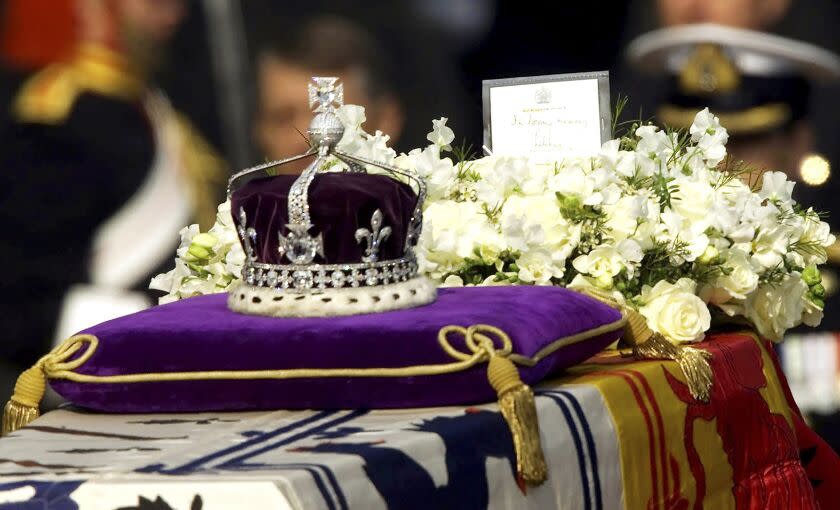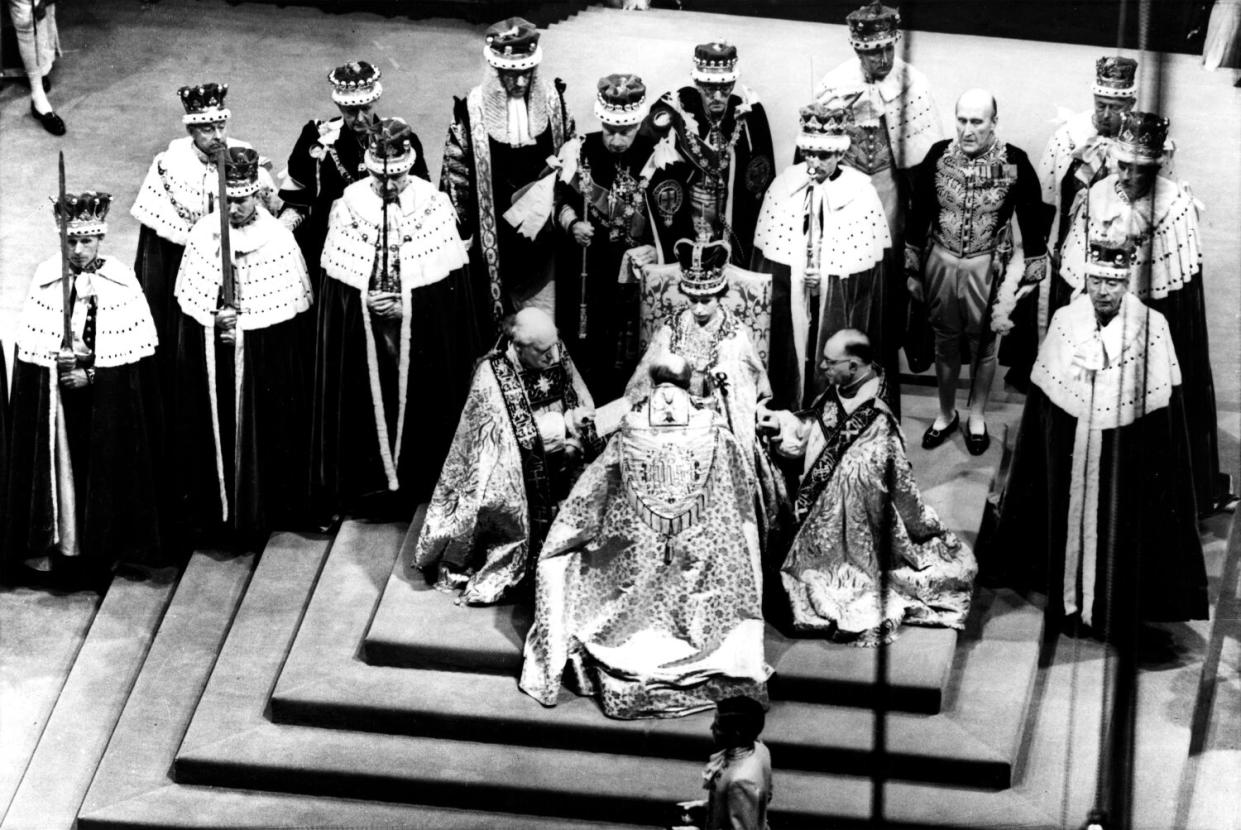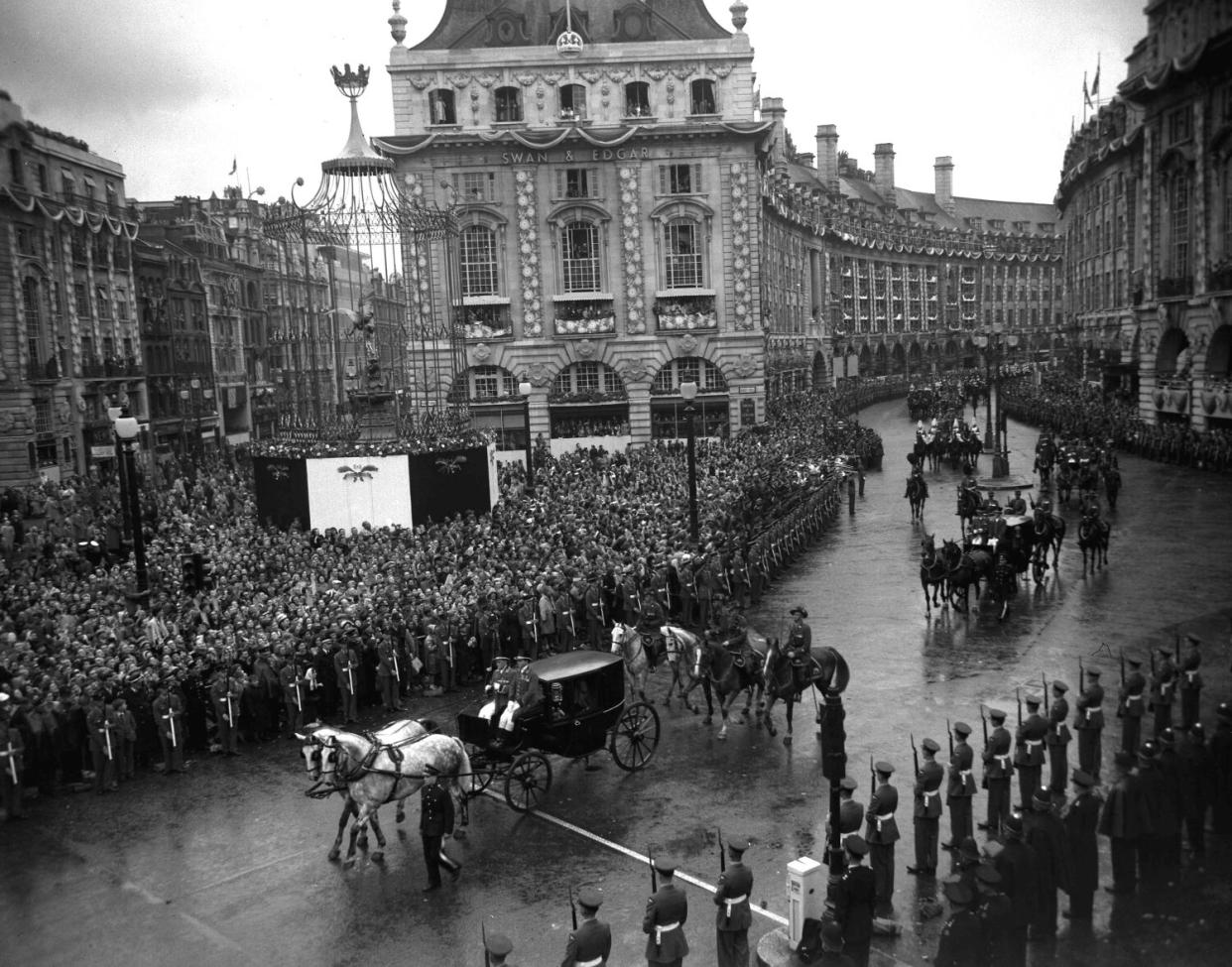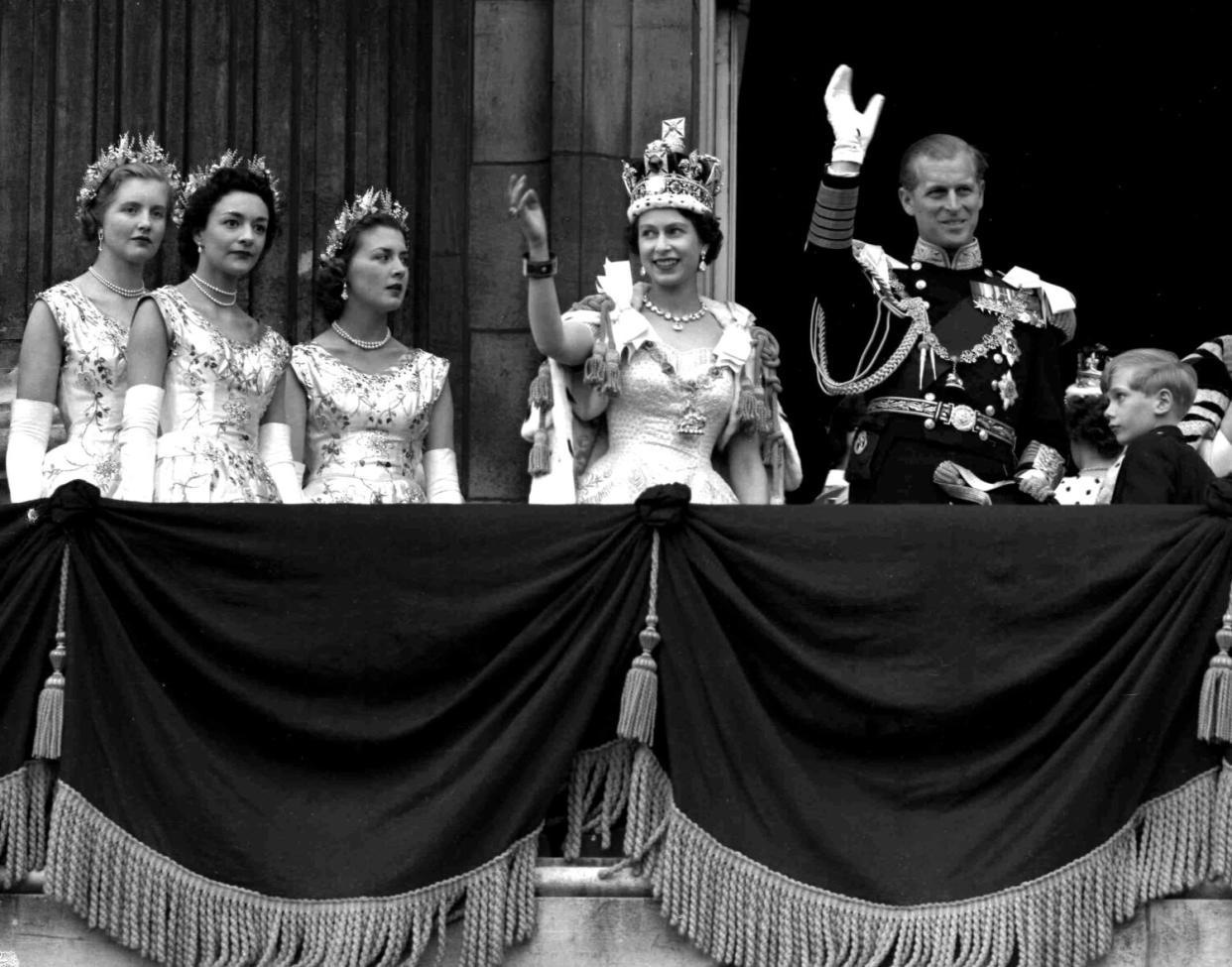What's with the weird spoon, jeweled orb and scepters at King Charles III's coronation?

The oldest crown ever found in England, a dented bronze circlet, turned up two days after Christmas 1988, a full 2,000 years after both it and the man who wore it — now no more than a skull — were buried on a chalk ridge in the county of Kent.
Skip ahead 20 centuries to other British crowns. On Saturday, one of them will crown the latest king in the 39th coronation at Westminster Abbey. It has not been used in 70 years, since it crowned his mother at the last coronation. Another crown will sit on the head of his wife, the new queen; until now, it has been on display for those 70 years in the Tower of London.
Museums in Europe are filled with the jeweled relics of kings and queens, the supreme headgear of monarchy. The difference — that immensely profitable difference that draws people to London from democracies and republics and dictatorships the world over — is that in Britain, once in a while, these objects emerge from the display cases and come to life again for their purpose: as the living ceremonial ornaments of a singularly surviving monarchy.
It’s a splendid haul.
Much of what you’ll see in the coronation of Charles III dates from the 1660s. In the many decades since, monarchs couldn’t afford to keep real stones in their crowns. They rented them to pop into the settings for big occasions, then returned them to jewel dealers. Only with the cornucopia of jewels cascading from the British Empire into Queen Victoria’s vaults were valuable stones placed permanently into the regalia.
So here’s some — but by no means all — of the bling to track.

Those sweet, sweet rides
Technically not bling, but the first big, gold-y thing you’ll see — as the uncrowned king and queen head to Westminster Abbey, along a route about one-third the length of that taken by Queen Elizabeth II for her coronation in 1953 — is the Australian State Coach.
The vehicle that will roll out of the Buckingham Palace gates was a gift from, you guessed it, Australia in 1988. Using it here is a gesture toward the nation the new king wants to keep in the Commonwealth family. It looks like ye olde coache, but it has electric windows, AC and hydraulic suspension.
Both Charles and Camilla have bad backs, and for the trip back to Buckingham Palace, the newly crowned monarchs will ride in grand discomfort in that 1763 beast the Gold State Coach. How big is it? I consulted Luis Chiappe, who directs the Dinosaur Institute at the L.A. County Natural History Museum, to make sure: The Gold State Coach, 29 feet long, 12 feet high, weighing four tons, is approximately like having a gilded triceratops mounted on wheels and rolled down London streets. It has special armrests to support the royal arms that are holding paraphernalia like scepters. From the outside, it looks glorious; from the inside, it’s wretched. Queen Victoria wrote of its “distressing oscillations,” and the late Queen Elizabeth II described it simply as “horrible.”

Crowns: the original golden arches
Britain’s most important crowns have arches over the top. These can signify that the kingdom is an empire unto itself, not subject to any authority but God’s, which is why there’s a cross. They can also just make the crown sturdier, or both.
As for tiaras: Brace yourselves, ye lovers of grandeur and glitter, for there are distressing reports that, as part of scaling down and cutting back on the glitter factor, Catherine, the Princess of Wales and the next queen, will wear not a tiara but a circlet of flowers. The horror! Charles wants a low-key event — but no tiaras? That’s like the Angelenos who wear cargo shorts and tank tops to opening night at the opera!
(Side note: Peers and peeresses — dukes, marquises and marchionesses, earls and countesses and so on — have been asked not to wear their traditional ermine-and-red-velvet cloaks, or the silver-gilt coronets of their rank. Peers can be notoriously eccentric, so who knows what outfits they might wear instead — maybe cargo shorts? — but this is not an unmixed blessing. Those robes can stink of mothballs, and poorer peers have been known to rent-a-robe, or to use rabbit fur and apply smudges of charcoal to replicate the patterns of ermine.)
Now for the starring bling.
St. Edward’s Crown
Charles will be crowned with St. Edward’s Crown. St. Edward the Confessor was a bona fide saint and English king who died in 1066, not long before England was invaded by that William the Conqueror guy, the illegitimate son of a French Norman duke and a tanner’s daughter. This crown is the 1660s version of the original, and it’s worn only once in any reign: for the coronation.
It’s not as valuable as other crowns, for it’s set with mostly semiprecious stones. But 22-karat gold is heavy, and this crown weighs about five pounds. Before her coronation, Elizabeth II sat at her desk wearing it in order to get used to its weight.
If you want to feel the burden of royalty, try wearing a five-pound sack of flour on your head for three hours.

The Imperial State Crown
Just as Charles III will change from a red velvet cloak to one of purple after he’s crowned, so will he remove St. Edward’s Crown and put on the Imperial State Crown. It’s the same crown he’ll wear every year for the opening of Parliament. It weighs less than half as much as St. Edward’s Crown, so, whew.
And it’s much more valuable, with nearly 3,000 diamonds and extraordinary, historic jewels. The biggest of these, gleaming like a headlamp in a miner’s hard hat, is the 317-carat Cullinan II. It’s the second-largest stone cut from a 3,106-carat monster diamond given to King Edward VII in 1907, after the Boer War, by a British-run region of South Africa. Above that is a 170-carat lump of red, the Black Prince’s ruby, supposedly worn in the helmet of Henry V at his improbable victory over the French at Agincourt. (“We few, we happy few” — that Shakespeare bit.) Above are pearls that belonged to Queen Elizabeth I. The second Queen Elizabeth loved pearls and felt sorry for these — they look “not very happy,” she said, because pearls are “like living things, they need warming.” They get no cuddles in the Tower of London.
At the back of the crown is the oblong 104-carat Stuart sapphire. It used to be at the front but got demoted to make way for the Cullinan II diamond. A truly ancient sapphire, St. Edward’s, is at the center of the Maltese cross on top. Fairly good authorities say it was found when the saint-king’s body was moved to the abbey nearly 900 years ago.
Even though this crown is lighter than the coronation crown, Queen Victoria wrote that it “hurt me a good deal.” Queen Elizabeth II described it as “unwieldy,” especially when trying to read a speech; you had to hold the speech in front of you, because if you looked down to read it, the crown "would fall off.”
Queen Mary’s Crown
King Charles III adored his grandmother, Queen Elizabeth the Queen Mother, and probably would have liked his wife, Camilla, to wear her crown for the coronation. But it comes with too much political baggage, 105 carats' worth — the contentious Koh-i-Noor diamond, a trophy of 19th century empire that the Indian government would very much like back.
Instead, Camilla will be crowned with the crown that Charles’ great-grandmother, Queen Mary, wife of King George V, received in 1911. It had the Koh-i-Noor mounted in it then, but the stone has been removed. We may see in its place Cullinans III and IV, a mere 95 and 63 carats, respectively, along with Cullinan V, 19 carats, all cut from that same heart-size raw diamond.
This is the first time in almost 300 years that a queen consort has been crowned with another queen’s crown; Charles is a great believer in recycling.
Rings ...
The coronation ring has been called "England's Wedding Ring" probably since Queen Elizabeth I kept getting grief for not getting married. She would hold up her right hand and show off the ring, nowadays a classic St. George’s Cross of sapphires and rubies, and tell her critics that she was already married — to England. At Queen Victoria’s coronation, the clergyman forced it onto the wrong finger, and the 19-year-old queen wrote that she had “the greatest difficulty” in getting it off her swollen digit, and “not without great pain.”
... and other things
Coronations miss no opportunity to load up on the symbolism, including that massive royal Golden Snitch called the Orb. It too dates from 1661, but earlier monarchs all had one. This one is about the size of a cantaloupe, and even hollow, it weighs about 2½ pounds. It is girded with jewels and topped with a jeweled cross to show Jesus’ dominion over the world.
Even a sovereign has only two hands, so near the end of the ceremony, the monarch has to set the Orb on the altar to hold the two scepters.
Sticks with stones (big precious ones)
So much to keep straight: The scepter with cross paradoxically stands for secular authority under God. It goes in the right hand. And the scepter with dove, for spiritual influence and the Holy Ghost, goes in the left.
The dove one — Edward the Confessor’s symbol — is nice enough, but that scepter with the cross will knock your eye out.
There at the top, glittering like an ice floe, is Cullinan I, the Star of Africa, 530 carats of virtually perfect diamond-ness. The monarch walks out of the Abbey and into that dinosaur gold coach carrying both scepters. Queen Camilla will have her own hands full, with the 1685 consort’s cross-topped scepter, a hefty gold rod with a diamond-studded handle for a sure grip, and — likely to displease William, Prince of Wales — another 1685 scepter, this one made of elephant ivory and topped with a dove. William has campaigned ferociously against ivory as “a symbol of destruction, not luxury,” and he reportedly wants all of the royal family’s ivory baubles to be destroyed. Camilla could take a cue from that dove of peace on the other scepter and refuse to carry the ivory scepter, as a peacemaking gesture to her stepson.
Not your average spoon
The oldest piece of English regal regalia is … a spoon. It was certainly used at the coronation of King Richard the Lionhearted almost 900 years ago, but for what purpose, no one’s exactly sure — certainly not for eating.
The gilded silver spoon escaped the Parliamentary melting pot because a man who’d once worked for the king bought it for 16 shillings. He returned it to King Charles II for his coronation, probably to suck up to royal favor again.
During the coronation, it’s filled with a special holy oil, and the Archbishop of Canterbury dips his fingers into it to anoint the monarch. He’ll make the sign of the cross in oil on Charles’ head, chest and hands.
That’s well pared down from medieval anointings like those on Henry IV. Lèse-majesté, I know, but he must have gleamed like a Roman gladiator after being oiled on his arms, shoulders and back, as well as his hands, chest and head, where he had a king-size case of lice going. We won’t be able to see Charles’ anointing because, like his mother before him, he has chosen to screen himself from the public’s view during the most sacred part of the coronation.
Camilla’s anointing might or might not take place in public view. When Edward VII’s queen, Alexandra, was anointed in 1902, she worried that the oil wouldn’t “take” if the archbishop put it on her hair, because she wore false curls. So he put it on her forehead instead, but it trickled onto her nose, where it would have been indiscreet to wipe it away, however much it may have tickled.
A quintet of swords
Five swords will figure in the coronation.
The sword of state is carried in front of the monarch on many occasions as a reminder of royal power (not much these days).
The sword of offering is so gorgeous that it would almost be a pleasure to be stabbed by it. It was made for the incredibly fancy coronation — 20 times more expensive than most others — of that fat King George IV, who did have taste, if not the money to underwrite it. This sword cost almost 6,000 pounds in 1820 money (nearly 468,000 pounds, or $584,000, in today's).
Three other swords, symbols of spiritual justice, mercy and temporal justice, are walked in front of the sovereign, just as they were as far back as Richard the Lionhearted. They’re all pointing upward, unsheathed, reminding everyone of the monarch’s powers. The sword of mercy, called Curtana, has a blunt tip because ... mercy.
This story originally appeared in Los Angeles Times.
